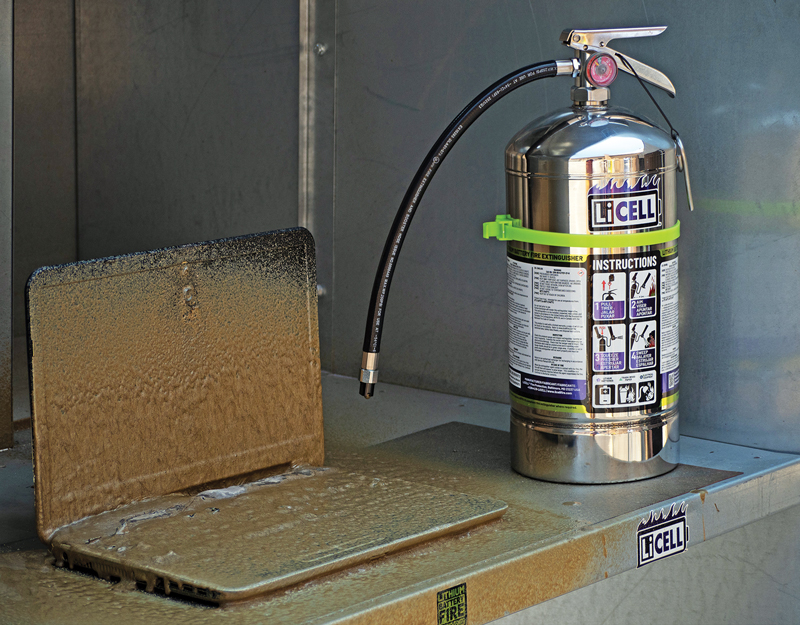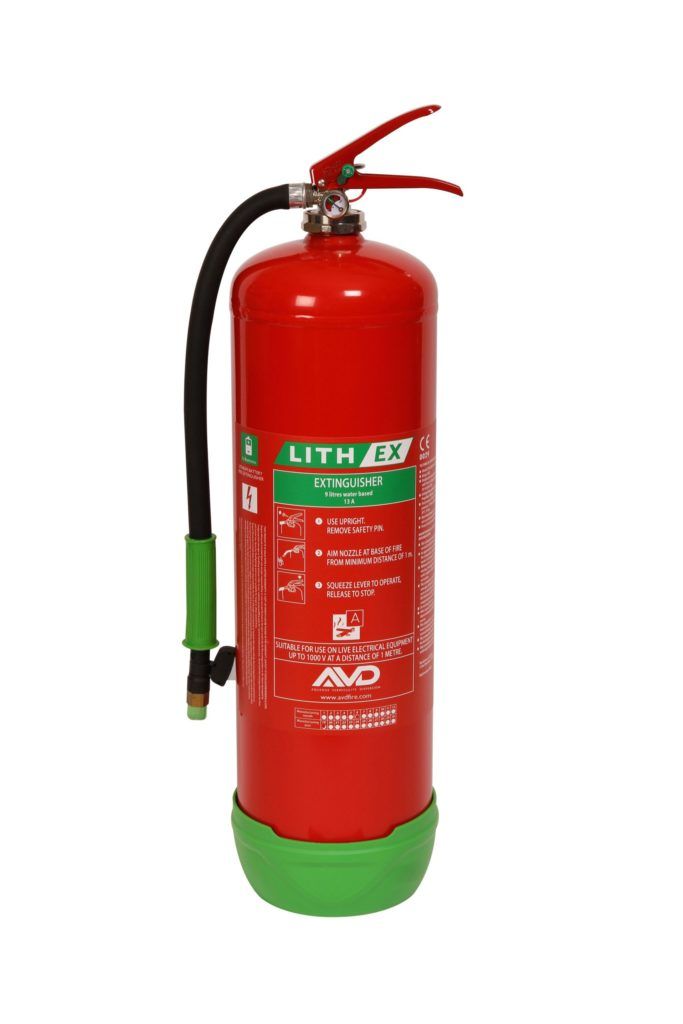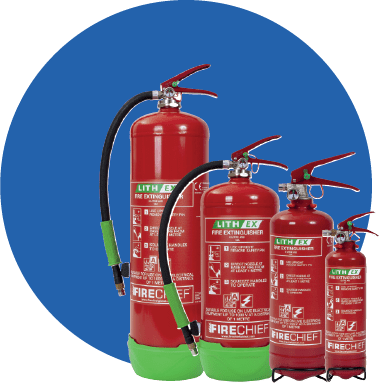A lithium battery fire extinguisher is designed to combat fires caused by lithium-ion batteries. These extinguishers use specialized agents to suppress and cool the flames.
Lithium-ion batteries power many devices, from smartphones to electric vehicles. Their increasing usage raises concerns about fire safety. Standard fire extinguishers are ineffective against lithium battery fires. These fires require specialized extinguishers that can handle high temperatures and prevent re-ignition.
Lithium battery fire extinguishers often use dry powder or other agents tailored to lithium fires. They are essential in environments where lithium batteries are prevalent, such as data centres, manufacturing facilities, and workshops. Investing in the correct fire extinguisher can protect property and lives, ensuring safety in the presence of lithium batteries.

Credit: www.proboat.com
The Rise Of Lithium Batteries
Lithium batteries have become essential in our daily lives. They power our gadgets, vehicles, and even homes. Their lightweight nature and high energy density make them ideal for modern technology.
Pervasiveness In Modern Technology
Lithium batteries are found in almost every modern device. From smartphones and laptops to electric cars, they are everywhere. Their ability to store much energy in a small space is unparalleled.
Electric vehicles (EVs) rely heavily on lithium batteries. These batteries provide the necessary power for long-distance travel. They also recharge quickly, making them convenient for daily use.
Portable electronics like tablets, cameras, and drones also use lithium batteries. These batteries ensure these devices are lightweight and easy to carry.
Hazards Of Lithium Batteries
Despite their benefits, lithium batteries pose significant hazards. They can overheat, leading to fires or explosions. This happens due to thermal runaway, a chain reaction of overheating.
Damaged batteries are hazardous. If punctured or crushed, they can catch fire. This is a risk during transportation or after a device is dropped.
The chemicals inside lithium batteries are also hazardous. They can cause burns or other injuries if they leak. Proper handling and disposal are crucial to avoid these dangers.
| Device | Battery Type | Potential Hazard |
|---|---|---|
| Smartphone | Lithium-ion | Overheating |
| Laptop | Lithium-ion | Fire |
| Electric Car | Lithium-ion | Explosion |
| Drone | Lithium-polymer | Crash Fire |
To mitigate these risks, lithium battery fire extinguishers are essential. They are explicitly designed to combat fires caused by lithium batteries. Investing in these extinguishers can save lives and property.
Understanding Lithium Battery Fires
Lithium batteries power many of our devices today. They are in phones, laptops, and cars. But these batteries can catch fire. Understanding why and how to stop it is crucial.
What Makes Lithium Batteries Flammable?
Lithium batteries have a high energy density. This means they store a lot of energy in a small space. If something goes wrong, this energy can be released quickly. This quick release can cause fires.
The batteries contain flammable materials. The electrolyte inside the battery is a liquid that can burn. If the battery casing breaks, the electrolyte can leak. This leak can start a fire.
Short circuits are another risk. If the battery’s internal parts touch each other, it can cause a short circuit. This might produce heat and start a fire.
Thermal Runaway: The Chain Reaction
Thermal runaway is a dangerous chain reaction. It starts with a small problem, like a short circuit. This problem generates heat. The heat causes the battery to break down.
As the battery breaks down, it releases more heat. This extra heat can cause other parts of the battery to fail. The failing parts release more heat, continuing the cycle.
Thermal runaway can spread from one battery to others nearby. If one battery catches fire, it can cause a fire in the next battery. This makes it hard to control lithium battery fires.
Here is a table summarizing the key points:
| Cause | Description |
|---|---|
| High Energy Density | Stores a lot of energy in a small space |
| Flammable Electrolyte | Liquid inside can burn if leaked |
| Short Circuits | Internal parts touching can generate heat |
| Thermal Runaway | Chain reaction of heat causing battery breakdown |
Preventing Lithium Battery Fires
Lithium battery fires can be dangerous. They occur because of improper charging, storage, or handling. By following simple safety measures, you can prevent these fires. This section will cover safe charging practices and storage and handling tips.
Safe Charging Practices
Charging lithium batteries needs caution. Make sure you always use the charger that comes with the device. Avoid using cheap or third-party chargers. Overcharging can cause fires. So, unplug the charger when the battery is full. Follow these tips to stay safe:
- Use the correct charger.
- Unplug after a full charge.
- Avoid overcharging.
- Charge in a safe area.
- Keep an eye on the charging process.
Storage And Handling Tips
Proper storage and handling are crucial to preventing lithium battery fires. Store batteries in a cool, dry place. Avoid storing in direct sunlight. Use a fireproof container if possible. Handle batteries with care. Follow these tips:
- Store in a cool, dry place.
- Avoid direct sunlight.
- Use fireproof containers.
- Handle with care.
- Keep away from metal objects.
| Do’s | Don’ts |
|---|---|
| Use the manufacturer’s charger | Overcharge the battery |
| Store in a cool, dry place | Expose to direct sunlight |
| Handle with care | Use damaged batteries |
Types Of Fire Extinguishers For Lithium Batteries
Lithium batteries are standard in many devices. They need special fire extinguishers to put out fires. Different fire extinguishers work better for lithium batteries.
Traditional Extinguishers Vs. Lithium-specific Options
Traditional fire extinguishers include water, foam, and CO2 types. These work well for many fires. But they are not the best for lithium battery fires.
Lithium-specific fire extinguishers are made for lithium battery fires. They use special chemicals to put out these fires. This keeps people and property safe.
| Type | Use | Effectiveness |
|---|---|---|
| Water | General fires | Low for lithium fires |
| Foam | General fires | Low for lithium fires |
| CO2 | Electrical fires | Low for lithium fires |
| Lithium-specific | Lithium battery fires | High |
The Role Of Class D Extinguishers
Class D fire extinguishers are for metal fires. These include lithium fires. They use dry powder to put out the fire. This stops the reaction and cools the battery.
Class D extinguishers are very effective for lithium fires. They are a must-have for places with many lithium batteries.
- Safe: They prevent the fire from spreading.
- Practical: They quickly put out lithium fires.
- Specialized: They are made for metal fires.
Selecting The Right Fire Extinguisher
Choosing a suitable fire extinguisher for lithium battery fires is crucial. It ensures safety and effectiveness in emergencies. Understand the critical factors before making a decision.
Factors To Consider
When selecting a fire extinguisher for lithium batteries, consider these factors:
- Fire Class: Lithium battery fires fall under Class D fires.
- Extinguisher Type: Choose an extinguisher specifically designed for metal fires.
- Size and Weight: Ensure the extinguisher is easy to handle.
- Certification: Look for UL or similar certifications.
- Ease of Use: The extinguisher needs to be simple to use.
Recommended Products For Different Settings
Different settings require different types of extinguishers. Here are some recommendations:
| Setting | Recommended Product |
|---|---|
| Home | Kidde 466180 Pro 5 Carbon Dioxide – Lightweight and easy to use. |
| Office | Amerex B500 – Effective and reliable for small spaces. |
| Industrial | H3R Performance MX250R – Suitable for larger areas and heavy-duty use. |
Choosing a suitable fire extinguisher can save lives and property. Always ensure you have the best option for your specific setting.
Using A Lithium Battery Fire Extinguisher
Lithium batteries power many modern devices, from smartphones to electric cars. But they can be dangerous when they catch fire. Using a lithium battery fire extinguisher can save lives and property. This guide will walk you through the steps to safely use this vital tool.
Step-by-step Guide
Follow these steps to use a lithium battery fire extinguisher effectively:
- Identify the Fire: Ensure the fire involves lithium batteries. These fires are often intense and produce a lot of smoke.
- Keep a Safe Distance: Stand at least 6 feet from the fire.
- To use the extinguisher, pull the pin, which will rupture the tamper seal.
- Aim the Nozzle: Aim the nozzle away from the flames and toward the centre of the fire.
- To discharge the extinguishing agent, squeeze the handle.
- Sweep Side to Side: Move the nozzle side to side, covering the entire fire area.
- Monitor the Fire: Watch the area to ensure the fire does not reignite.
Common Mistakes To Avoid
Here are some common mistakes to avoid when using a lithium battery fire extinguisher:
- Using Water: Water can make lithium battery fires worse. Always use a proper lithium battery fire extinguisher.
- Standing Too Close: Being too close to the fire can be dangerous. Stand at least 6 feet away.
- Rather than aiming directly at the flames, aim toward the fire’s base. This is more effective in putting out the fire.
- Not Monitoring the Fire: After extinguishing, watch the area to ensure the fire does not reignite.
Understanding how to use a lithium battery fire extinguisher properly can be crucial in emergencies. Always follow these steps and avoid common mistakes for the best results.
Disposal Of Lithium Batteries And Post-fire Cleanup
Handling lithium batteries requires care. Disposal and cleanup are critical tasks. This section covers how to dispose of lithium batteries and clean up after a fire.
Proper Disposal Protocols
Proper disposal of lithium batteries is essential to prevent fires and environmental harm. To guarantee safe disposal, adhere to the following guidelines:
- Lithium batteries should never be thrown in conventional garbage cans.
- Use designated recycling centres for lithium batteries.
- Store used batteries in cool, dry places until disposal.
- Insulate battery terminals with tape to avoid short circuits.
Local authorities often provide disposal guidelines. Check your local waste management website for specific instructions.
Cleaning Up After A Lithium Battery Fire
A lithium battery fire can be hazardous. Follow these steps for a safe cleanup:
- Ensure the area is ventilated to disperse toxic fumes.
- Wear protective gear like gloves and masks.
- Use appropriate fire extinguishers designed for lithium fires.
- Collect residue using non-metallic tools.
- Dispose of debris following hazardous waste protocols.
Seek professional help for large fires or extensive damage. Professionals have the right equipment and expertise.
| Task | Details |
|---|---|
| Dispose of Batteries | Use designated recycling centres. |
| Ventilate Area | Open windows and doors for airflow. |
| Wear Protective Gear | Use gloves and masks. |
| Collect Residue | Use non-metallic tools. |
Always prioritize safety and follow local guidelines for disposal and cleanup. Proper handling prevents further hazards.

Credit: www.fsmatters.com
Future Of Lithium Battery Safety
Lithium batteries power many of our devices. They are in phones, laptops, and cars. These batteries are powerful but can catch fire. The future of lithium battery safety is crucial. New technologies aim to prevent fires. New rules ensure safer batteries. Let’s explore these advancements.
Advancements In Fire Suppression Technology
Fire suppression technology is evolving. New extinguishers target lithium battery fires. These extinguishers use special chemicals. They cool the battery quickly. They also prevent re-ignition. Fire blankets can also help. They smother the fire. Sprinkler systems are getting upgrades. They can now detect lithium battery fires. They release the right chemicals to put out the fire.
| Technology | Function |
|---|---|
| Specialized Extinguishers | Excellent batteries quickly and prevent re-ignition |
| Fire Blankets | Smother the fire |
| Upgraded Sprinkler Systems | Detect and extinguish lithium battery fires |
Regulations And Standards
New regulations aim to make lithium batteries safer. These rules set standards for battery production. They require safe materials and designs. Manufacturers must follow strict guidelines. These rules help prevent fires. They also protect users. International standards are also evolving. They ensure batteries are safe worldwide. Testing is more rigorous now. Batteries must pass many tests before they reach consumers.
- Safe materials and designs are required.
- Manufacturers follow strict guidelines.
- International standards ensure global safety.
- Batteries undergo rigorous testing.
The future of lithium battery safety looks promising. New technologies and rules aim to prevent fires. They ensure our devices are safe to use.

Credit: www.avdfire.com
Frequently Asked Questions
Which Kind of Fire Extinguisher Is Required When Using Lithium Batteries?
A Class D fire extinguisher is needed for lithium battery fires. It handles explicitly combustible metal fires safely.
Can A Lithium Battery Fire Be Extinguished?
Yes, you can extinguish a lithium battery fire. Apply sand or a Class D fire extinguisher. Always avoid water.
What Special Fire Extinguisher For EV batteries?
Use a Class D fire extinguisher for EV battery fires. It contains a dry powder that is effective for lithium-ion batteries.
How To Put Out A Lithium Battery Fire On A Boat?
Use a Class D fire extinguisher designed for lithium fires. Cool the battery with water to prevent re-ignition. Evacuate the area and call for help. Ensure proper ventilation to disperse fumes. Regularly inspect and maintain batteries to prevent fires.
Conclusion
A lithium battery fire extinguisher is essential for safety. It effectively handles dangerous battery fires. Investing in one can prevent potential disasters. Stay safe by being prepared with the right tools. A lithium battery fire extinguisher ensures you are ready for any emergency.
Protect your property and loved ones today.

I am a battery specialist writer and blogger based in the USA & UK . I have been working with battery power energy for 3 long years and I give trips on low battery power problem and solutions . I have a lot of experience with battery power and I share them here.

